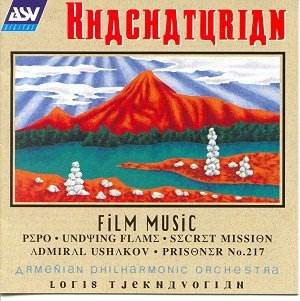Aram KHACHATURYAN (1903-1978)
Film Music
Pepo (1934)
Undying Flame (1956)
Secret Mission (1950)
Admiral Ushakov (1953)
Prisoner 217 (1945)
 Armenian PO/Loris
Tjeknavorian
Armenian PO/Loris
Tjeknavorian
rec 22-23 Oct 1995, Yerevan, Armenia
 ASV CD DCA 966
[66.35]
ASV CD DCA 966
[66.35]
Amazon USA

Garish colours, vivid (though often familiar) ideas and an oriental twist
to the themes are what we expect from such a collection and we are not
disappointed.
Pepo, dating from the year of Khachaturyan's first symphony, was a
massive success across the USSR. Its theme song created a real popular splash.
Primary colours are rife. Subtlety is not the name of the game. There is
a grand march like a Russian El Cid. Oriental elements unwind and
gloriously vulgar and amplified by the old-style Russian horns of the orchestra.
The Undying Flame mixes the saturation of the ASV trademark colours
of the CD sleeve into the sound which is jumpy and adrenalin-stirring. Hammering
oppression is racked up and relieved only by the stateliness of the music
for Dance Before The Queen. The Gavotte draws on Prokofiev's
Romeo and Juliet, the Battle on Mossolov's machine music, Rossini's
William Tell and Bernard Herrmann (unknowingly) and the Finale, on
Tchaikovsky's 5th Symphony.
The Secret Mission, in five movements, is taut as a steel hawser
at breaking strain, gorgeously garish and unsubtly triumphant. The Pilot
produces music as if from a belligerent Sousa with tractor-loads of Soviet
'attitude'. The Admiral Ushakov score, written in the year of Stalin's
death, was very extensive. Here we have only five sections: a brilliant battle
scene and a cataclysmic march of stately tread with atmosphere traced direct
from the opening measures of Tchaik 5 and the finale of Tchaik 6. The Finale
reaches a little too readily for the cymbals and is not short of Korngoldian
bombast.
Prisoner 217 was among the first films to be released in the Union
after the end of World War 2. It is murderously atmospheric, piston-fast,
retaining all the impact of a metal girder in flight and reminiscent, in
In the Prison, of Shostakovich Symphony No. 5. In the final long sequence
the music 'evolves' into an outrageous Commissar's strut from a comparatively
understated 'valse triste'.
The notes by Robert Matthew-Walker are supportive.
This should not be missed by any pursuer of Khachaturyan's music. It will
also be attractive to anyone searching out Russian film music. Can we hope
that we will see these films one day? I hope so. I would rather explore and
reassess these than face the prospect of another pallet-full of made for
TV American films or indeed many of the current commercial efforts.
Reviewer
Rob Barnett

